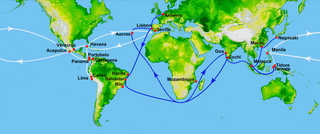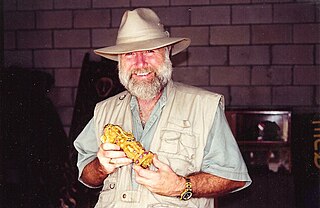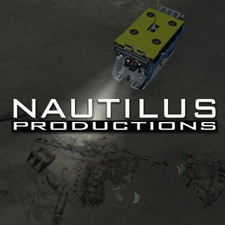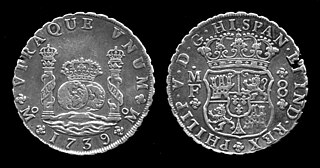
A shipwreck is the wreckage of a ship that is located either beached on land or sunken to the bottom of a body of water. Shipwrecking may be intentional or unintentional. There were approximately three million shipwrecks worldwide as of January 1999, according to Angela Croome, a science writer and author who specialized in the history of underwater archaeology.
Mel Fisher was an American treasure hunter best known for finding the 1622 wreck of the Nuestra Señora de Atocha in Florida waters.

Nuestra Señora de Atocha was a Spanish treasure galleon and the most widely known vessel of a fleet of ships that sank in a hurricane off the Florida Keys in 1622. At the time of her sinking, Nuestra Señora de Atocha was heavily laden with copper, silver, gold, tobacco, gems, and indigo from Spanish ports at Cartagena and Porto Bello in New Granada and Havana, bound for Spain. The Nuestra Señora de Atocha was named for the Basilica of Nuestra Señora de Atocha in Madrid, Spain. It was a heavily armed Spanish galleon that served as the almirante for the Spanish fleet. It would trail behind the other ships in the flotilla to prevent an attack from the rear.

The Spanish treasure fleet, or West Indies Fleet, was a convoy system of sea routes organized by the Spanish Empire from 1566 to 1790, which linked Spain with its territories in the Americas across the Atlantic. The convoys were general purpose cargo fleets used for transporting a wide variety of items, including agricultural goods, lumber, various metal resources such as silver and gold, gems, pearls, spices, sugar, tobacco, silk, and other exotic goods from the overseas territories of the Spanish Empire to the Spanish mainland. Spanish goods such as oil, wine, textiles, books and tools were transported in the opposite direction.

Queen Anne's Revenge was an early-18th-century ship, most famously used as a flagship by Edward Teach, better known by his nickname Blackbeard. The date and place of the ship's construction are uncertain, and there is no record of its actions prior to 1710 when it was operating as a French privateer under the name La Concorde. Surviving features of the ship's construction strongly suggest it was built by French shipwrights, based on differences in fastening patterns in the late 17th and early 18th centuries. After several years of service by French sailors, she was captured by Blackbeard in 1717. Blackbeard used the ship for less than a year, but captured numerous prizes using her as his flagship.

SS Republic was a sidewheel steamship, originally named SS Tennessee, lost in a hurricane off the coast of Georgia in October 1865, en route to New Orleans.
The Antikythera wreck is a Roman-era shipwreck dating from the second quarter of the first century BC.

The archaeology of shipwrecks is the field of archaeology specialized most commonly in the study and exploration of shipwrecks. Its techniques combine those of archaeology with those of diving to become Underwater archaeology. However, shipwrecks are discovered on what have become terrestrial sites.
Urca de Lima is a Spanish shipwreck near Fort Pierce, Florida, United States. She was part of the 1715 Treasure Fleet, one of the numerous Spanish treasure fleets sailing between Spain and its colonies in the Americas. The wreck is located north of Fort Pierce Inlet, 200 yards off the shore from Jack Island Park. It became the first Florida Underwater Archaeological Preserve when dedicated in 1987. This was followed on May 31, 2001 with its addition to the U.S. National Register of Historic Places.

The 1715 Treasure Fleet was actually a combination of two Spanish treasure fleets returning from the New World to Spain, the "Nueva España Fleet", under Capt.-General Don Juan Esteban de Ubilla, and the "Tierra Firme Fleet", under Don Antonio de Echeverz y Zubiza. At two in the morning on Wednesday, July 31, 1715, seven days after departing from Havana, Cuba, all eleven ships of the fleet were lost in a hurricane along the east coast of Florida. A 12th ship, the French frigate "Le Grifon", had sailed with the fleet. Its captain was unfamiliar with the Florida coastline and elected to stay further out to sea. The "Grifon" safely returned to Europe.
The Georgiana was a brig-rigged, iron hulled, propeller steamer belonging to the Confederate States Navy during the American Civil War. Reputedly intended to become the "most powerful" cruiser in the Confederate fleet once her guns were mounted, she was never used in battle. On her maiden voyage from Scotland, where she was built, she encountered Union Navy ships engaged in a blockade of Charleston, South Carolina, and was heavily damaged before being scuttled by her captain. The wreck was discovered in 1965 and lies in the shallow waters of Charleston's harbor.

Edward Lee Spence is a pioneer in underwater archaeology who studies shipwrecks and sunken treasure. He is also a published editor and author of non-fiction reference books; a magazine editor, and magazine publisher ; and a published photographer. Spence was twelve years old when he found his first five shipwrecks.
Edgerton Alvord Throckmorton, known as Peter Throckmorton, was an American photojournalist and a pioneer underwater archaeologist.

Robert F. Marx was an American pioneer in scuba diving, a prolific author, and was best known for his work as an avocational marine archaeologist. Over his career, he discovered over 5000 shipwrecks in over 60 countries. Although some accused him of treasure hunting, fellow avocational archeologist E. Lee Spence described Marx as the "true father of underwater archaeology". Marx also helped write UNESCO legislation regarding shipwrecks.
The Convention on the Protection of the Underwater Cultural Heritage is a treaty that was adopted on 2 November 2001 by the General Conference of the United Nations Educational, Scientific and Cultural Organization (UNESCO). The convention is intended to protect "all traces of human existence having a cultural, historical or archaeological character" which have been under water for over 100 years. This extends to the protection of shipwrecks, sunken cities, prehistoric art work, treasures that may be looted, sacrificial and burial sites, and old ports that cover the oceans' floors. The preservation of underwater cultural heritage is significant as it allows for the retelling of numerous historical events. As part of its duty to conduct scientific research and provide continuous education on the importance of underwater cultural heritage, UNESCO strives to maintain these sites for the enjoyment of current and future generations. The convention may provide a customary framework to help raise awareness and seek to combat the illegal looting and pirating occurring in waters worldwide. As an international body, member states of the convention agree to work towards the preservation of sunken cultural property within their jurisdiction and the high seas.
The Black Swan Project is the project name given by Odyssey Marine Exploration for its discovery and recovery of an estimated US$500 million worth of silver and gold coins from the ocean floor. Initially Odyssey kept the origin of the treasure confidential. It was later proved in trial that the recovered cargo was being carried by the Spanish frigate Nuestra Señora de las Mercedes, which was sunk by the British Royal Navy off Portugal in 1804.
Odyssey Marine Exploration, Inc. is an American company engaged in deep-ocean exploration with a focus on the exploration, development and validation of subsea mineral resources. Starting out as a shipwreck pioneer, Odyssey has discovered some of the most famous deep-ocean shipwrecks in history, including Ancona, Gairsoppa, Nuestra Señora de las Mercedes, Republic, and HMS Victory. Their work has been featured on the Discovery Channel, PBS and National Geographic.

Nautilus Productions LLC is an American video production, stock footage, and photography company incorporated in Fayetteville, North Carolina in 1997. The principals are producer/director Rick Allen and photographer Cindy Burnham. Nautilus specializes in documentary production and underwater videography, and produced QAR DiveLive, a live webcast of underwater archaeology filmed at the wreck of the Queen Anne's Revenge in 2000 and 2001.

El Salvador alias El Henrique was a Spanish treasure ship that ran aground near present-day Beaufort Inlet, North Carolina during a hurricane in August 1750. She was traveling with six other Spanish merchantmen including the Nuestra Señora De Soledad which went ashore near present-day Core Banks, NC and the Nuestra Señora de Guadalupe which went ashore near present-day Ocracoke, NC.















